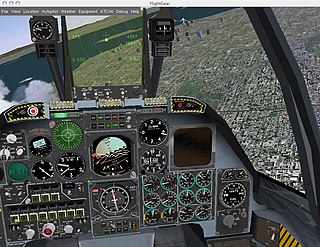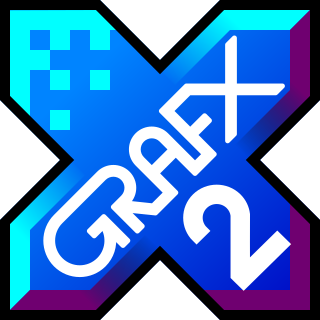
The Battle for Wesnoth is a free and open-source turn-based strategy video game with a high fantasy setting, designed by Australian-American developer David White and first released in June 2003. In Wesnoth, the player controls a particular faction/race and attempts to build a powerful army by controlling villages and defeating enemies for experience. The game is loosely based on the Sega Genesis games Master of Monsters and Warsong.

An open-source video game, or simply an open-source game, is a video game whose source code is open-source. They are often freely distributable and sometimes cross-platform compatible.

SuperTuxKart (STK) is a free and open-source kart racing game, distributed under the terms of the GNU General Public License, version 3. It features mascots of various open-source projects. SuperTuxKart is cross-platform, running on Linux, macOS, Windows, iOS (beta), Android systems and Nintendo Switch (homebrew).

GrafX2 is a bitmap graphics editor inspired by the Amiga programs Deluxe Paint and Brilliance. It is free software and distributed under the GPL-2.0-only license.
Cocos2d is an open-source game development framework for creating 2D games and other graphical software for iOS, Android, Windows, macOS, Linux, HarmonyOS, OpenHarmony and web platforms. It is written in C++ and provides bindings for various programming languages, including C++, C#, Lua, and JavaScript. The framework offers a wide range of features, including physics, particle systems, skeletal animations, tile maps, and others.
Open Game Art is a media repository intended for use with free and open source software video game projects, offering open content assets.

Frogatto & Friends is a platform game with adventure elements released in July 2010. The game received positive reviews, particularly for its "gorgeous" pixel art. The game is cross-platform and runs on Linux, AmigaOS4, AROS, Mac OS X, Microsoft Windows, iOS and BlackBerry Tablet OS. The game uses an open-source engine, with game data mostly proprietary and partly under Creative Commons BY license.
WebP is a raster graphics file format developed by Google intended as a replacement for JPEG, PNG, and GIF file formats. It supports both lossy and lossless compression, as well as animation and alpha transparency.

Simple and Fast Multimedia Library (SFML) is a cross-platform software development library designed to provide a simple application programming interface (API) to various multimedia components in computers. It is written in C++ with bindings available for Ada, C, Crystal, D, Euphoria, Go, Java, Julia, .NET, Nim, OCaml, Python, Ruby, and Rust. Experimental mobile ports were made available for Android and iOS with the release of SFML 2.2.

Orx is an open-source, portable, lightweight, plug-in-based, data-driven and easy to use 2D-oriented game engine written in C.

GPUOpen is a middleware software suite originally developed by AMD's Radeon Technologies Group that offers advanced visual effects for computer games. It was released in 2016. GPUOpen serves as an alternative to, and a direct competitor of Nvidia GameWorks. GPUOpen is similar to GameWorks in that it encompasses several different graphics technologies as its main components that were previously independent and separate from one another. However, GPUOpen is partially open source software, unlike GameWorks which is proprietary and closed.

LDAC is a proprietary audio coding technology developed by Sony, which allows streaming high-resolution audio over Bluetooth connections at up to 990 kbps at 32 bits/96 kHz. It is used by various products, including headphones, earphones, smartphones, portable media players, active speakers, and home theaters.

Phaser is a 2D game framework used for making HTML5 games for desktop and mobile. It is free software developed by Photon Storm.










